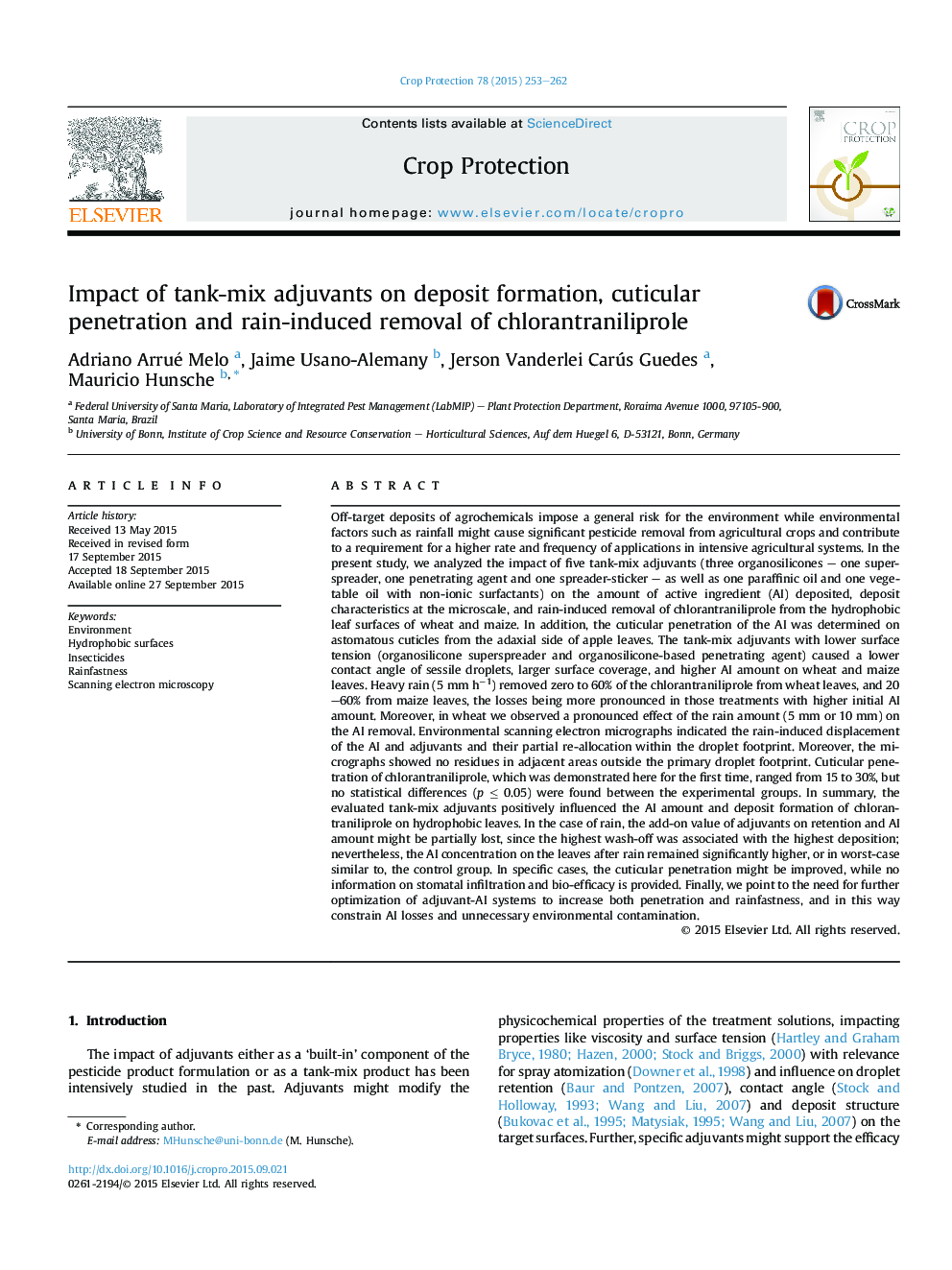| کد مقاله | کد نشریه | سال انتشار | مقاله انگلیسی | نسخه تمام متن |
|---|---|---|---|---|
| 4505695 | 1624309 | 2015 | 10 صفحه PDF | دانلود رایگان |

• We studied the behavior of chlorantraniliprole applied to hydrophobic leaves.
• Scanning electron micrographs demonstrate the interaction pesticide–plant surface.
• Adjuvants decreased surface tension and increased AI amount deposited on leaves.
• Pesticide removal by heavy rain was positively related to the initial deposit.
• Rain-induced wash-off reached 60% of the applied product.
Off-target deposits of agrochemicals impose a general risk for the environment while environmental factors such as rainfall might cause significant pesticide removal from agricultural crops and contribute to a requirement for a higher rate and frequency of applications in intensive agricultural systems. In the present study, we analyzed the impact of five tank-mix adjuvants (three organosilicones – one superspreader, one penetrating agent and one spreader-sticker – as well as one paraffinic oil and one vegetable oil with non-ionic surfactants) on the amount of active ingredient (AI) deposited, deposit characteristics at the microscale, and rain-induced removal of chlorantraniliprole from the hydrophobic leaf surfaces of wheat and maize. In addition, the cuticular penetration of the AI was determined on astomatous cuticles from the adaxial side of apple leaves. The tank-mix adjuvants with lower surface tension (organosilicone superspreader and organosilicone-based penetrating agent) caused a lower contact angle of sessile droplets, larger surface coverage, and higher AI amount on wheat and maize leaves. Heavy rain (5 mm h−1) removed zero to 60% of the chlorantraniliprole from wheat leaves, and 20–60% from maize leaves, the losses being more pronounced in those treatments with higher initial AI amount. Moreover, in wheat we observed a pronounced effect of the rain amount (5 mm or 10 mm) on the AI removal. Environmental scanning electron micrographs indicated the rain-induced displacement of the AI and adjuvants and their partial re-allocation within the droplet footprint. Moreover, the micrographs showed no residues in adjacent areas outside the primary droplet footprint. Cuticular penetration of chlorantraniliprole, which was demonstrated here for the first time, ranged from 15 to 30%, but no statistical differences (p ≤ 0.05) were found between the experimental groups. In summary, the evaluated tank-mix adjuvants positively influenced the AI amount and deposit formation of chlorantraniliprole on hydrophobic leaves. In the case of rain, the add-on value of adjuvants on retention and AI amount might be partially lost, since the highest wash-off was associated with the highest deposition; nevertheless, the AI concentration on the leaves after rain remained significantly higher, or in worst-case similar to, the control group. In specific cases, the cuticular penetration might be improved, while no information on stomatal infiltration and bio-efficacy is provided. Finally, we point to the need for further optimization of adjuvant-AI systems to increase both penetration and rainfastness, and in this way constrain AI losses and unnecessary environmental contamination.
Journal: Crop Protection - Volume 78, December 2015, Pages 253–262